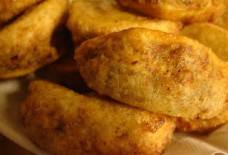A Chicken Pie That’s Well Worth the Wait
BY: DAVID DANIS
A simplified version of pastilla, the savory Moroccan pastry served on festive occasions, this recipe can be broken up so the process is part of the fun.
By David Tanis
Though I am by no means an expert in Moroccan cuisine, I have long been an ardent admirer. Even before my first visit, I began dabbling, learning from cookbooks.
Over the years, I have become quite comfortable making a small repertoire of dishes of which I never tire: I love the abundant use of spices in Moroccan food, the frequent presence of lemons and green olives, the smell of steaming buttered couscous.
Some dishes are easily prepared; others, like pastilla (also known as b’stillah or bsteeya), a well-known savory pastry, require a definite commitment. This somewhat-simplified version involves a lot of steps, but it can be broken down so you can enjoy the process.
The main work is braising the chicken, which is simmered to tenderness with onions and sweet spices, like turmeric, saffron, ginger, allspice and, especially, cinnamon. Torn into shreds, the perfumed chicken mixture must be rather highly seasoned.
You can make the chicken filling up to a day in advance of serving, or assemble the entire pie and refrigerate, unbaked, up to a day ahead. (The actual building of the pie takes relatively little time.)
In Morocco, thin pastry leaves called warqa are used to make the pie’s flaky layers; elsewhere, most cooks use more readily available phyllo, which is definitely recommended for beginners. (To learn more about making warqa, look online for videos of the process — fascinating, but a bit daunting.)
I like to assemble the pie in a 12-inch paella pan, but a large skillet or springform cake pan would work well. The pan is lined with seven layers of well-buttered phyllo sheets, which hang well beyond the pan’s edges. In goes the cooled filling, along with chopped toasted almonds and pistachios. (My version is dotted with lemony ricotta, rather than the more traditional lemony scrambled egg.) Then the overhanging phyllo is folded over the top and tucked in to make a compact pie.
The pie is baked until beautifully golden brown, then inverted onto a platter and served warm. The final step is dusting the pie generously with powdered sugar, like a thin layer of fallen snow. It might sound odd, but this combination of sweet flaky pastry and savory braised chicken is truly beguiling.
For Moroccan weddings and other festive occasions, pastilla is traditionally a first course, followed by many other celebratory dishes. At my house, it’s a fancy rich main course, followed by a guilt-assuaging bright green salad.
Recipe: Moroccan Chicken Pie


